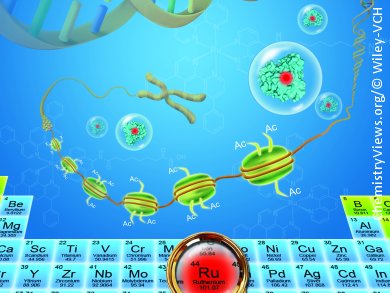Chemical modifications of histones, such as acetylation and methylation, play a major role in gene regulation. Histone acetyltransferases (HATs) promote N-acetylation of ε-lysine tails on histone, which leads to greater transcription. Histone deacetylases (HDACs) catalyze the removal of acetyl groups, which results in transcriptional repression. HDAC inhibitors (HDACis) show potent anticancer activities by promoting the acetylation of histones and non-histone proteins and inducing transcriptional events involved in growth arrest, differentiation, and apoptotic cell death.
Zong-Wan Mao, Cai-Ping Tan, and co-workers, Sun Yat-sen University, China, have designed and synthesized a series of fluorescent RuII polypyridyl complexes, which contain the ligand N1-hydroxy-N8-(1,10-phenanthrolin-5-yl)octanediamide (L), and target HDACs as anticancer agents. The ligand, L, was synthesized in two steps and the complexes were formed by heating the relevant ruthenium polypyridyl precursor with ligand, L. All of these complexes can inhibit HDAC activity. Mechanistic studies show that [Ru(DIP)2L](PF6)2 (DIP=4,7-di-phenyl-1,10-phenanthroline) exhibits potent in vitro cytotoxicity by inducing apoptosis through mitochondrial dysfunction and the generation of reactive oxygen species.
- Histone-Deacetylase-Targeted Fluorescent Ruthenium(II) Polypyridyl Complexes as Potent Anticancer Agents,
Rui-Rong Ye, Zhuo-Feng Ke, Cai-Ping Tan, Liang He, Liang-Nian Ji, Zong-Wan Mao,
Chem. Eur. J. 2013.
DOI: 10.1002/chem.201300814




